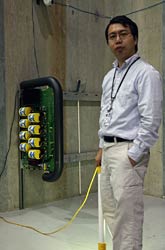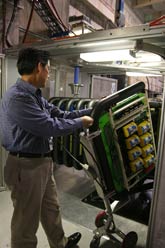
Handy Links
SLAC News Center
SLAC Today
- Subscribe
- Archives: Feb 2006-May 20, 2011
- Archives: May 23, 2011 and later
- Submit Feedback or Story Ideas
- About SLAC Today
SLAC News
Lab News
- Interactions
- Lightsources.org
- ILC NewsLine
- Int'l Science Grid This Week
- Fermilab Today
- Berkeley Lab News
- @brookhaven TODAY
- DOE Pulse
- CERN Courier
- DESY inForm
- US / LHC
SLAC Links
- Emergency
- Safety
- Policy Repository
- Site Entry Form

- Site Maps
- M & O Review
- Computing Status & Calendar
- SLAC Colloquium
- SLACspeak
- SLACspace
- SLAC Logo
- Café Menu
- Flea Market
- Web E-mail
- Marguerite Shuttle
- Discount Commuter Passes
-
Award Reporting Form
- SPIRES
- SciDoc
- Activity Groups
- Library
Stanford
Around the Bay
Keeping Power Levels Smooth and Steady
Two months into what will be a year of intensive testing, researchers and engineers with SLAC's Power Conversion Engineering group are making strides in improving the stability of the Marx modulator. The modulator, which is designed to provide power for the proposed International Linear Collider, converts out-of-the-wall AC power into the 120,000-volt pulses of energy that would be needed to drive the ILC klystrons.
The goals is to demonstrate that the modulator is capable of providing reliable power over long-term use. The work comes as a follow up to initial testing conducted earlier this year.
The Marx modulator consists of 16 identical cells, each capable of delivering up to 11,000 volts. The cells store energy serially, one at a time, but discharge all at once, producing enormous pulses of energy. The cells recharge after each pulse and within a fraction of a second are ready to go again. Because the cells recharge only after the end of the pulse, the energy output decreases across the length of each pulse, with the voltage falling by as much as 40 percent from beginning to end. According to Power Conversion Engineering head Craig Burkhart, in order for the modulators to provide reliable energy for the ILC klystrons, that number has to come down dramatically.
"The output voltage of [the Marx modulator] has to be carefully controlled within plus or minus half a percent," Burkhart said. "That's important for the stability of the microwave source that it powers."
To reach this goal, researchers operate the cells in groups. Eleven of the 16 cells discharge at first, the other five stepping in sequentially as the voltage drops on the first eleven—a technique that brings the voltage fluctuations down to 10 percent. To get within 1 percent, researchers introduce what is called a vernier Marx—a device that looks much like one of the main cells, but works like a miniature version of the system as a whole.
"As the main Marx starts to droop, these little Marx cells are turned on, providing a correction to fill in the rest of the fluctuations," Burkhart said.
Researchers on the project completed tests on the vernier Marx last week, and are now upgrading the modulator's control system. In September, the modulator will be reconnected to a prototype klystron to resume life testing. By using the modulator to power the klystron, researchers will get a better idea of what remains to be done.
"These are new systems," Burkhart said. "They've been tested and demonstrated to work, but the next questions are, as they continue to operate over time, what, if anything, will fail and what, if any, improvements need to be made."
—Nicholas Bock
SLAC Today, August 24, 2009

